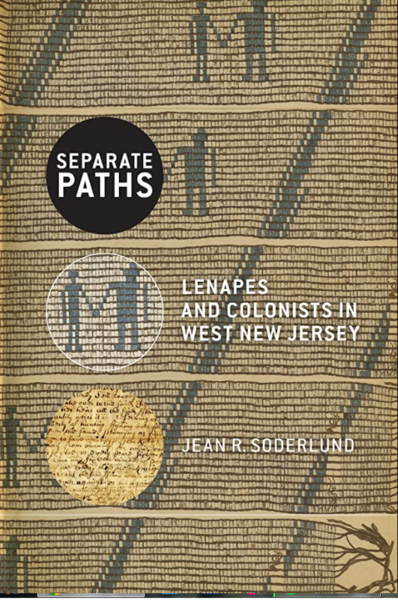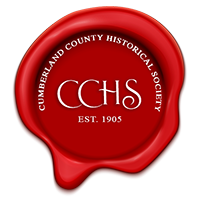

Speaker Series: “Separate Paths: Lenapes and Colonists in West New Jersey” by Jean R. Soderlund
March 26, 2023 @ 2:00 pm - 4:00 pm
Jean R. Soderlund will be discussing her latest book titled: Separate Paths: Lenapes and Colonists in West New Jersey.
The event will be available in person and via zoom. Please email us by March 25th at brittlp48@gmail.com if you would like to attend virtually. The zoom link will be emailed on the day of the event.
Book Overview:
Separate Paths: Lenapes and Colonists in West New Jersey is the first cross-cultural study of European colonization in the region south of the Falls of the Delaware River (now Trenton). Lenape men and women welcomed their allies, the Swedes and Finns, to escape more rigid English regimes on the west bank of the Delaware, offering land to establish farms, share resources, and trade. In the 1670s, Quaker men and women challenged this model with strategies to acquire all Lenape territory for their own use and to sell as real estate to new immigrants. Though the Lenapes remained sovereign and “old settlers” retained their Swedish Lutheran religion and ethnic autonomy, the West Jersey proprietors had considerable success in excluding Lenapes from their land. The Friends believed God favored their endeavor with epidemics of smallpox and other European diseases that destroyed Lenape families and communities. Affluent Quakers also introduced enslavement of imported Africans and Natives—and the violence that sustained it—to a colony they had promoted with the liberal West New Jersey Concessions of 1676-77. Thus, they defied their prior experience of religious persecution and their principles of peaceful resolution of conflict, equality of everyone before God, and the golden rule to treat others as you wish to be treated. Despite mutual commitment to peace by Lenapes, old settlers, and Friends, Quaker colonization had similar results to military conquests of Natives by English in Virginia and New England, and Dutch in the Hudson Valley and northern New Jersey. Still, in alliance with old settlers, Lenape communities survived in areas outside the focus of English colonization, in the Pine Barrens, upper reaches of streams, and Atlantic shore.
Jean R. Soderlund is a professor of history emeritus at Lehigh University in Bethlehem, Pennsylvania. Her books include Lenape Country: Delaware Valley Society before William Penn and Quakers and Slavery: A Divided Spirit, which received the New Jersey Historical Commission’s Alfred E. Driscoll Dissertation Prize.
Share This Story, Choose Your Platform!
CUMBERLAND COUNTY HISTORICAL SOCIETY’S SITES TO SEE AND VISIT ALONG YE GREATE STREET IN GREENWICH
· 1730 Gibbon House – This well-preserved townhouse was erected by Nicholas Gibbon, who built his home in the village because it was convenient for his shipping business. The house is an excellent example of Flemish bond patterned brick work, with red and blue alternating headers and stretchers forming the pattern and a pent-roof. (Hours open: Tuesday through Sunday – 1 to 4 p.m. Closed January, February and March.)
· Cumberland County Log Granary – When the granary was built, this part of South Jersey was known as New Sweden. It is said to be the oldest agricultural building in the United States. (Same hours as the Gibbon House.)
· 1930 Red Barn Museum – On display are items once used in the homes, farms and industries of Cumberland County. (Same hours as the Gibbon House.)
· Warren and Reba Lummis Genealogical & Historical Library – This modern building (1969) was constructed in an authentic colonial style in order to harmonize with the other buildings on Ye Great Street. The decorative spikes on the slate roof prevent snow or ice from sliding off the roof. Originally built as a bank, the building is now owned by the Society and houses its genealogical library and many documents pertinent to the county’s history. (Hours open: Wednesday – 10 a.m. to 4 p.m.; Saturday and Sunday – 1 to 4 p.m.)
· 1852 John DuBois Maritime Museum – This museum is home to an extraordinary collection of South Jersey Maritime artifacts collected by John DuBois. Visitors can step back in time and learn of Greenwich’s rich maritime history. It provides a look at the water industry that flourished in the area until the Second World War. Exhibits include models of oyster boats that once plied the bay. (Hours open: April through mid-December – Sundays only 1 – 4 p.m.)
· Alan Ewing Carman Museum of Prehistory in Cumberland County – This museum is home to the Archeological American Indian and Fossil Collection of Alan Ewing Carman. They were collected over fifty-one years of field work. (Hours open: Wednesday, Saturday and Sunday – 1 to 4 p.m. Closed January, February and March.)
· 1908 Tea Burners’ Monument – The monument was erected in 1908 to commemorate the burning of tea in protest of the hated British Tea Tax. No event in the history of Cumberland County has received such recognition or has been so highly honored as this act on the part of the young patriots whose names are listed on the monument.
OTHER SITES IN CUMBERLAND COUNTY MANAGED BY THE HISTORICAL SOCIETY
Cumberland County Liberty Bell – located in the Cumberland County Courthouse, Broad Street, Bridgeton, New Jersey
Potter’s Tavern – located on Broad Street in Bridgeton, New Jersey (Open on July 4th each year.)
Old Stone Church – located in Fairfield Township, Bridgeton, New Jersey
Additional information on front page.

